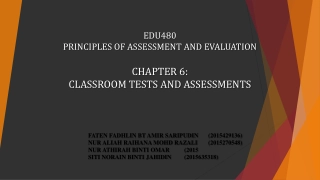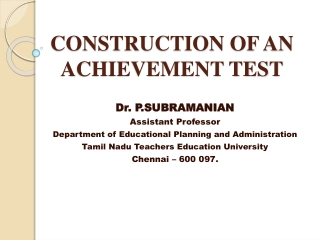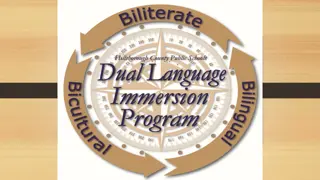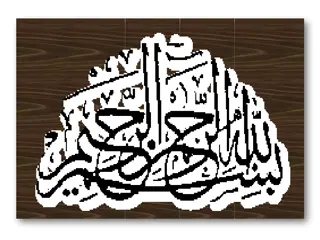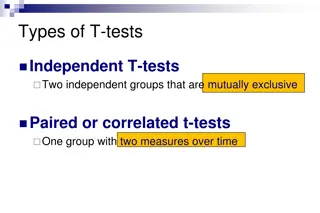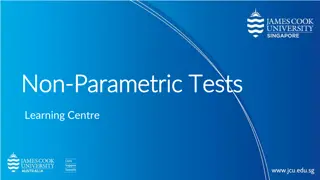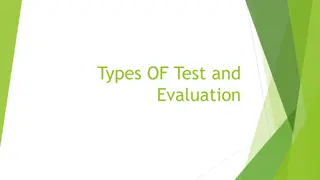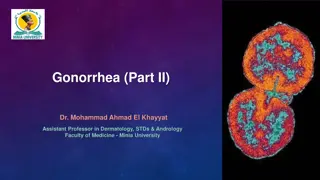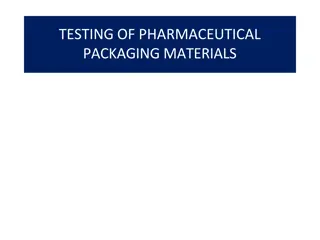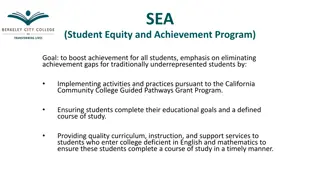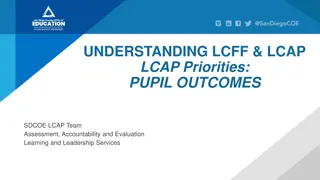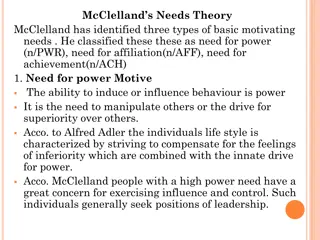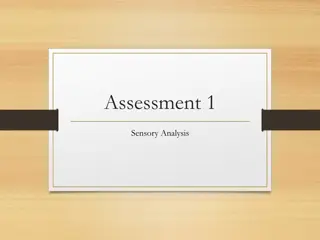Understanding Achievement Tests in Education
Achievement tests play a crucial role in assessing student progress in schools, aiding curriculum planning, and evaluating teaching programs. These tests measure individual accomplishments after a period of learning, helping to determine the effectiveness of instruction. Characteristics such as reliability, validity, objectivity, equilibrium, and specificity are essential for maintaining the quality and accuracy of achievement tests. Understanding the significance and classification of these tests is vital for improving educational outcomes.
Download Presentation

Please find below an Image/Link to download the presentation.
The content on the website is provided AS IS for your information and personal use only. It may not be sold, licensed, or shared on other websites without obtaining consent from the author. Download presentation by click this link. If you encounter any issues during the download, it is possible that the publisher has removed the file from their server.
E N D
Presentation Transcript
ACHIEVEMENT TEST BY- KAVITA SRIVASTAVA
ACHIEVEMENT TEST Achievement test is an important tool in school evaluation and has great significance in measuring instructional progress and progress of the students in the subject area. Accurate achievement data are very important for planning curriculum and instruction and for program evaluation.
DEFINITION Any test that measures the attainments and accomplishments of an individual after a period of training or learning - N M Downie . The type of ability test that describes what a person has learned to do Thorndike and Hagen . A systematic procedure for determining the amount a student has learned through instructions Gronlund .
CLASSIFACTIONOF TEST ACHIEVEMENTTEST TEACHERMADE TEST STANDARDIZED TEST Written Practical Oral ShortAnswer Type Objective Type EssayType
CHARACTERISTICSOFACHIEVEMENT TESTS RELIABILITY - The degree of accuracy with which an exam, test measures, what it seeks to measure a given variable. A test good reliability means that the test taker will obtain the same test score over repeated testing as long as no other extraneous factors have affected the score. A good instrument will produce consistent scores. An instrument s reliability is estimated using a correlation coefficient of one type or another.
CONT. VALIDITY - Validity is the quality of a test which measures what it is supposed to measure. It is the degree to which evidence, common sense, or theory supports any interpretations or conclusions about a student based on his/her test performance. A test is valid when it produces consistent scores over time. Measures what it intends to measure. Can be objectively scored. It has representative norms. OBJECTIVITY - A test is objective when the scorer s personal judgment doesn t affect the scoring.
CONT. EQUILIBRIUM - Achievement of the correct proportion among questions allotted to each of the objectives & teaching content. SPECIFICITY - The items in a test should be specific to the objectives. Precise & clear. Items should be precise, clear so that the students can answer well and score marks.
CONT. TIME GENERALLY - the time given to students is always in short supply however the students too do not accept very long tests. Therefore a test should neither be very long nor very short. ACCEPTABILITY - A good test should be acceptable to student to whom its being given without regard to any specific situation that is the question given in the test should be neither very difficult nor very easy.
CONT. EASE IN ADMINISTRATION - A test is good only when the conditions of answering are simple (scientific and logical). Its instruction should be simple and clear. COST - A good test should be in expensive, not only from the view point of money but also from the view point of time and effort taken in the construction of a test.
OBJECTIVES Identify and explain reasons for performing tests. Understand testing terminology to communicate clearly with students and colleagues. Evaluate a test s validity and reliability. Select appropriate tests. Administer test protocols properly and safely.
FUNCTIONSOFTEST It provides basis for promotion to the next grade. To find out where each student stands in various academic areas. It helps in determination about the placement of the students in a particular section. To motivate the students before a new assignment has taken up. To expose pupil s difficulties which the teacher can help them to solve.
STEPS INVOLVED IN THE CONSTRUCTION OF ACHIEVEMENT TEST 1. Planning of test 2. Preparation of a design for the test 3. Preparation of the blue print 4. Writing of items 5. Preparation of the scoring key and marking scheme 6. Preparation of question-wise analysis
CONT. 1. Planning of test Objective of the Test Determine the maximum time and maximum marks . 2. Preparation of a design for the test Important factors to be considered in design for the test are: Weightage to objectives. Weightage to content. Weightage to form of questions. Weightage to difficulty level.
BLUEPRINT Subject: BIOLOGY OBJECTIVE KNOWLEDGEUNDERSTANDING APPLICATIONTOTAL TYPEOFQUESTIONObjectiveVeryShortLongObjectiveVeryShortLongObjectiveVeryShortLong Question = 33 Marks = 50 CELL1(15) 2(5) 1(5) 2(4) 4(1) 2(2) 4(1) DIVERSITY IN LIVINGORGNISM Question = 34 Marks = 52 1(15) 2(6) 4(1) 1(5) 2(4) 4(1) 2(2) Question = 33 Marks = 48 FOODRESOURCES1(14) 2(6) 1(5) 2(4) 4(1) 1(1) 2(2) PLANT No. Of Questions1(44) 2(17) 4(1) 1(15) 2(12) 4(3) 1(1) 2(6) 4(1) = 100 No. OfMarks44 + 34 + 4 = 8215 + 24 + 12 = 511 + 12 + 4 = 17 = 150 Number of marks outside bracket Number of question inside bracket
1. Weightage of objective S.NO OBJECTIVE MARKS PERCENTAGE 1. Knowledge 82 54.70% 2. Understanding 51 34.00% 3. Application 17 11.30% Total 150 100%
2. Weightageofcontentareas S.NO SUB UNIT MARKS PERCENTAGE 1. Cell : The basic unit of life 50 33.30 2. Diversity in living organism 52 34.70% 3. Food Resources : Plant 48 32.00% Total 150 100%
3. Weightage Of Different Types Of Questions TYPE OF QUESTIONS NO. OF QUESTIONS S.NO MARKS PERCENTAGE 1. Objective 60 60 40.00% 2. Very Short 35 70 46.70% 3. Long 5 20 13.30% Total 100 150 100%
4. Weightageofdifficultylevel S.NO DIFFICULTY LEVEL MARKS PERCENTAGE 1. 75 50.00% Easy 2. 40 26.70% Moderate 3. Hard 35 23.30 Total 150 100%
2019 BIOLOGY CLASS- IX TIME: 3hours TotalMarks:150 GeneralInstructions: (a) The question paper comprises of three section A, B and C. (b) All questions are compulsory. (c) Question 1 to 60 in section A are one mark questions. (d) Question 61 to 95 in section B are two marks questions. There are to be answered in about 30 words. (e) Question 96 to 100 in section C are four marks questions. These are to be answered in about 70 words.
QUESTIONS Subject : BIOLOGY Q1. Name the two organelles we have studied that contained their own genetic material ? Q2. What are the different between manure and fertilizers ? Q3. Both ascaris and earthworm are called worm and have similar appearance but are placed in different phyla. Give reason. Q4. Anita socked some seeds of green gram, wheat, maize, peas and tamarind in water. Next morning she tries to split the seeds. Which seeds she was able to split into two nearly equal halves? What can be concluded from this activity? Q5. There would to no plant if chloroplast did not exist. Justify the statement.
Subject:PHYSICS Q1. What is the acceleration of free fall ? Q2. Why does an object float or sink when placed on the surface of water ? Q3. Prove that if the earth attracts two bodies placed at same distance from the Centre of the earth with the same force , then their masses are equal. Q4. Apply an example of exhibiting inertia in our daily life. Q5. Demonstrate an example of a body which may appear to be moving for one person and stationary for the other .
Subject : CHEMISTRY Q1. What is an atom ? Q2. Compare the properties of electrons , protons and neutrons ? Q3. Distinguish between isotopes and isobar ? Q4. What information would you use/apply to support advantage of Nuclear Chemistry ? Q5. What facts would you select to show the need of Nuclear Energy in current scenario ?
Subject : ENGLISH Q1. Who is the known as the Missile Man of India ? Q2. What was Kabir against for ? Q3. How was the flute seller playing the flute ? Q4. Compare and contrast the atmosphere in and around the Baudhnath Shrine with that in the Pashupatinath Temple. Q5. In this modern age of today , how can we include the thoughts of saint Kabir in our life , express it in your language.
Subject:HISTORY Q1. Which country has the world s first written constitution ? Q2. How did the principle of free trade inspire the colonists to revolution ? Q3. Highlight the economic reasons for the French evolution ? Q4. Discuss the development of nationalism and explain the spread of nationalism throughout the world ! Q5. The French Revolution was a Escort incident, confirm this event !
Subject : COMMERCE Q1. What does modern form of money include ? Q2. How are socio cultural and economic factors responsible for poverty ? Q3. How do bank act as a mediator ? Q4. Describe the distribution of rice cultivation in India with special reference to Bihar and West Bengal ? Q5. How does money overcome the problem of barter system ? Explain briefly.
Subject : MATHEMATICS Q1. The relationship between mean, median and mode is ? Q2. Two concentric circles are of radii 5cm and 3cm. Find the length of the chord of the larger circle which touches the smaller circle. Q3. If tan A = cot B , prove that A + B = 90 Q4. The angle of elevation of the top of a tower 30m high from the foot of another tower in the same plane is 60 and the angle of elevation of the top of the second tower from the foot of the first tower is 30 . Find the distance between the two towers and also the height of the other tower. Q5. The median of the distribution given below is 14.4 . Find the value of x and y , if the total frequency is 20. Class of frequency 0-6 6-12 12-18 18-24 24-30 Frequency 4 x 5 y 1
Subject : COMPUTERSCIENCE Q1. What are the examples of input device and output device ? Q2. Illustrate the need of icon in our computer system and also draw any two of them ? Q3. Why is the primary memory called as main memory ? Q4. Demonstrate the usage of computer in our day today life? Q5. Why should one take some precautions in the computer room ?
ANSWERKEY I. Objective 1. Tick the correct options: (a) (b) (c) (d) (e) 2. Fill in the blanks: (a) (b) (c) (d) (e) 3. True and False: (a) (b) (c) (d) (e) 4. Match the following : (a) (b) (c) (d) (e) II. Very Short Answered 1. 2. 3. III. Long Answered 1. 2. 3.


